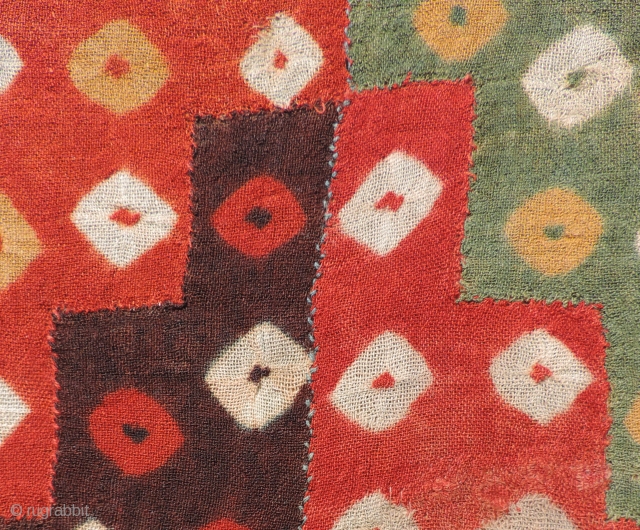Back
Beautiful, small Pre-Columbian tie-dyed textile. This is a very colorful and enduring object of ancient textile art dating from a.d. 400 - 800. It has been conserved to a neutral linen backing cloth and mounted for display the size is 20 x 17 inches as mounted. The actual textile size is 16 x 14 inches. This a beautiful example of a very complex weaving and dying process. It has a stepped - mihrab-like design, that is one of the most ancient of all Andean design motifs and is thought to represent a sacred mountain or "Apu". Certain Andean cultures constructed massive stepped platform mounds that replicated sacred mountains and acted as platforms for their most important rituals and ceremonies. Woven in the Nasca region of the South Coast of Peru this fragment was once part of a larger textile. More complicated than it appears, the weave is a delicate, glauze-like balanced plain weave in a discontinuous warp and weft structure. During the weaving process these elements were woven using temporary "scaffolding" yarns to connect them. Once off the loom, the individual stepped forms - woven in plain white alpaca yarns were separated into individual stepped elements. These were then tied off tightly in the places where the diamond shaped forms were wanted - so that the tied off areas would not take on dye. This tying off method created the white and the gold diamond-shaped forms of the finished product once the multi-step dying process was complete. The separated and tied pieces were dyed in several different dye baths creating the green, yellow, purple and red colors seen in the textile. Separate indigo and cochineal dye baths created the purple and red areas and an unknown yellow dye over a pale indigo - the green. After all dying was complete the ties were removed and the pieces were carefully reassembled using a needle to create the "dovetail" join for the warps. Finally, the weft slits were loosely sewn up creating the very fine nearly gauze-like finished textile. This time consuming and complicated process required tremendous skill and patience. It was done in this way to create a special, prestige cloth for ceremonial occasions. In the Andean region weavers never cut pieces of cloth into various shapes. By tradition, all textiles had to be woven and finished on the loom in the desired final form. This discontinuous warp and weft scaffold weaving method was invented in the Andes and was employed for the creation of important prestige cloth reserved for the elite of society. This combination of complex weaving and dying processes is not known to have occurred outside the Andes and is unique in the history of the textile arts.
price:
SOLD - THANK YOU
- Home
- Antique Rugs by Region
- Category
- Profiles
- Post Items Free
- Albums
- Benaki Museum of Islamic Art
- Budapest: Ottoman Carpets
- Gulbenkian Museum
- Islamic Carpets. Brooklyn
- Islamic Textiles. Brooklyn
- Konya Museum: Rugs
- MKG, Hamburg
- MMA: Caucasian Carpets
- MMA: Mamluk Carpets
- MMA: Mughal Indian Carpets
- MMA: Ottoman Carpets
- MMA: Safavid Persian Carpets
- MMA: Turkmen Rugs
- McCoy Jones Kilims
- Ottoman textiles. Met
- Philadelphia Museum
- Rugs and Carpets: Berlin
- Seljuqs at the Met
- TIEM, Istanbul: Carpets
- V&A: Classical Carpets
- Vakiflar Carpets: Istanbul
- Baluch Rugs: Indianapolis
- Gallery Exhibitions
- Jaf an Exhibition
- Alberto Levi Gallery
- Andean Textile
- Christie's London: 2016
- Francesca Galloway
- HALI at 40
- ICOC Washington, DC 2018
- Jajims of the Shahsavan
- London Islamic Week April, 2018
- Mongolian Felts
- Navajo Rugs: JB Moore
- Persian Piled Weavings
- SF Tribal & Textile Art Show 2020
- SF Tribal 2019
- Sotheby's: C. Alexander
- Turkish Prayer Rugs
- Turkmen Main Carpets ICOC 2007









